shRNA抑制CLIC1基因表达对小鼠肝癌细胞株Hca-F生物学行为的影响
- 格式:docx
- 大小:14.19 MB
- 文档页数:86
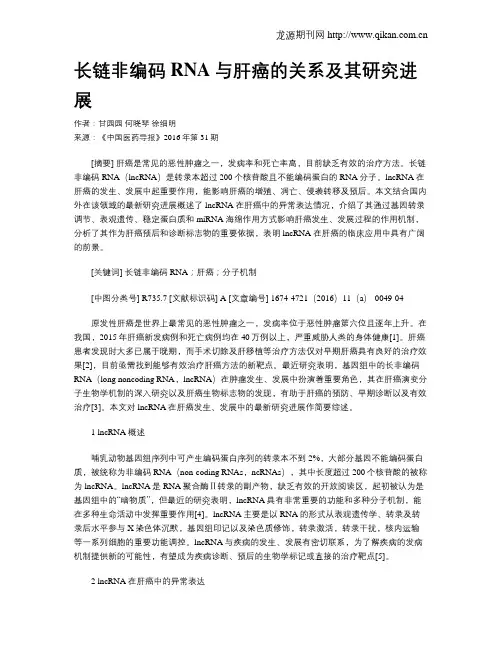
长链非编码RNA与肝癌的关系及其研究进展作者:甘园园何晓琴徐细明来源:《中国医药导报》2016年第31期[摘要] 肝癌是常见的恶性肿瘤之一,发病率和死亡率高,目前缺乏有效的治疗方法。
长链非编码RNA(lncRNA)是转录本超过200个核苷酸且不能编码蛋白的RNA分子。
lncRNA在肝癌的发生、发展中起重要作用,能影响肝癌的增殖、凋亡、侵袭转移及预后。
本文结合国内外在该领域的最新研究进展概述了lncRNA在肝癌中的异常表达情况,介绍了其通过基因转录调节、表观遗传、稳定蛋白质和miRNA海绵作用方式影响肝癌发生、发展过程的作用机制,分析了其作为肝癌预后和诊断标志物的重要依据,表明lncRNA在肝癌的临床应用中具有广阔的前景。
[关键词] 长链非编码RNA;肝癌;分子机制[中图分类号] R735.7 [文献标识码] A [文章编号] 1674-4721(2016)11(a)-0049-04原发性肝癌是世界上最常见的恶性肿瘤之一,发病率位于恶性肿瘤第六位且逐年上升。
在我国,2015年肝癌新发病例和死亡病例均在40万例以上,严重威胁人类的身体健康[1]。
肝癌患者发现时大多已属于晚期,而手术切除及肝移植等治疗方法仅对早期肝癌具有良好的治疗效果[2],目前亟需找到能够有效治疗肝癌方法的新靶点。
最近研究表明,基因组中的长非编码RNA(long noncoding RNA,lncRNA)在肿瘤发生、发展中扮演着重要角色,其在肝癌演变分子生物学机制的深入研究以及肝癌生物标志物的发现,有助于肝癌的预防、早期诊断以及有效治疗[3]。
本文对lncRNA在肝癌发生、发展中的最新研究进展作简要综述。
1 lncRNA概述哺乳动物基因组序列中可产生编码蛋白序列的转录本不到2%,大部分基因不能编码蛋白质,被统称为非编码RNA(non-coding RNAs,ncRNAs),其中长度超过200个核苷酸的被称为lncRNA。
lncRNA是RNA聚合酶Ⅱ转录的副产物,缺乏有效的开放阅读区,起初被认为是基因组中的“暗物质”,但最近的研究表明,lncRNA具有非常重要的功能和多种分子机制,能在多种生命活动中发挥重要作用[4]。
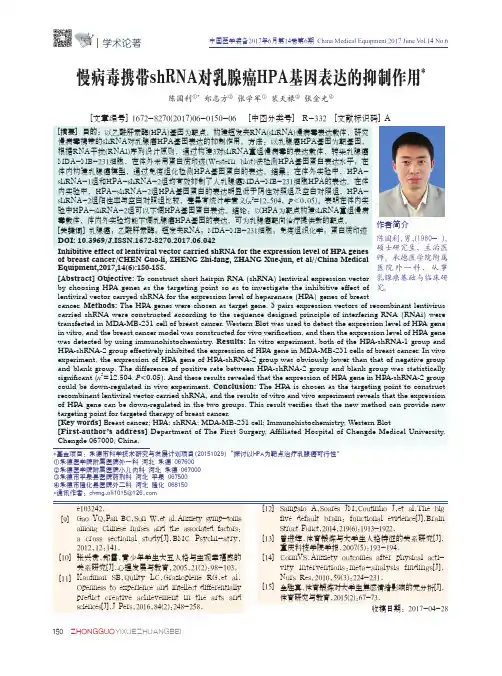
慢病毒携带shRNA对乳腺癌HPA基因表达的抑制作用cancer. Methods: The HPA genes were chosen as target gene, 3 pairs expression vectors of recombinant lentivirus carried shRNA were constructed according to the sequence designed principle of interfering RNA (RNAi) were transfected in MDA-MB-231 cell of breast cancer. Western Blot was used to detect the expression level of HPA gene in vitro, and the breast cancer model was constructed for vivo verification, and then the expression level of HPA gene was detected by using immunohistochemistry. Results: In vitro experiment, both of the HPA-shRNA-1 group and HPA-shRNA-2 group effectively inhibited the expression of HPA gene in MDA-MB-231 cells of breast cancer. In vivo experiment, the expression of HPA gene of HPA-shRNA-2 group was obviously lower than that of negative group and blank group. The difference of positive rate between HPA-shRNA-2 group and blank group was statistically significant (x 2=12.504, P <0.05). And these results revealed that the expression of HPA gene in HPA-shRNA-2 group could be down-regulated in vivo experiment. Conclusion: The HPA is chosen as the targeting point to construct recombinant lentiviral vector carried shRNA, and the results of vitro and vivo experiment reveals that the expression of HPA gene can be down-regulated in the two groups. This result verifies that the new method can provide new targeting point for targeted therapy of breast cancer.[Key words] Breast cancer; HPA; shRNA; MDA-MB-231 cell; Immunohistochemistry; Western Blot[First-author’s address] Department of The First Surgery, Affiliated Hospital of Chengde Medical University, Chengde 067000, China.作者简介陈国利,男,(1980- ),硕士研究生,主治医师。
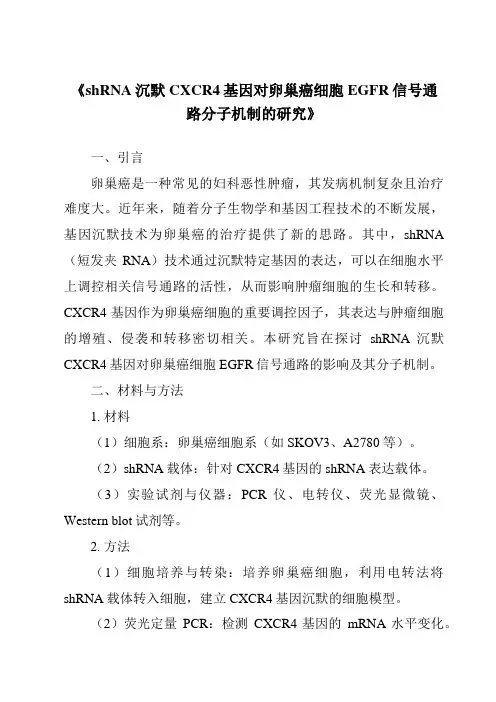
《shRNA沉默CXCR4基因对卵巢癌细胞EGFR信号通路分子机制的研究》一、引言卵巢癌是一种常见的妇科恶性肿瘤,其发病机制复杂且治疗难度大。
近年来,随着分子生物学和基因工程技术的不断发展,基因沉默技术为卵巢癌的治疗提供了新的思路。
其中,shRNA (短发夹RNA)技术通过沉默特定基因的表达,可以在细胞水平上调控相关信号通路的活性,从而影响肿瘤细胞的生长和转移。
CXCR4基因作为卵巢癌细胞的重要调控因子,其表达与肿瘤细胞的增殖、侵袭和转移密切相关。
本研究旨在探讨shRNA沉默CXCR4基因对卵巢癌细胞EGFR信号通路的影响及其分子机制。
二、材料与方法1. 材料(1)细胞系:卵巢癌细胞系(如SKOV3、A2780等)。
(2)shRNA载体:针对CXCR4基因的shRNA表达载体。
(3)实验试剂与仪器:PCR仪、电转仪、荧光显微镜、Western blot试剂等。
2. 方法(1)细胞培养与转染:培养卵巢癌细胞,利用电转法将shRNA载体转入细胞,建立CXCR4基因沉默的细胞模型。
(2)荧光定量PCR:检测CXCR4基因的mRNA水平变化。
(3)Western blot:检测CXCR4蛋白及EGFR信号通路相关分子的表达水平。
(4)细胞功能实验:通过MTT法、流式细胞术等实验手段,观察CXCR4基因沉默对卵巢癌细胞增殖、侵袭和迁移的影响。
(5)数据分析:采用GraphPad Prism软件进行数据分析与统计。
三、实验结果1. CXCR4基因沉默效果通过荧光定量PCR和Western blot实验,我们发现shRNA成功沉默了卵巢癌细胞中的CXCR4基因,其mRNA和蛋白水平均显著降低。
2. EGFR信号通路分子变化在CXCR4基因沉默后,我们发现EGFR信号通路的多个关键分子(如EGFR、PI3K、AKT等)的表达和磷酸化水平均发生明显变化。
这表明CXCR4基因的沉默可能影响了EGFR信号通路的活性。
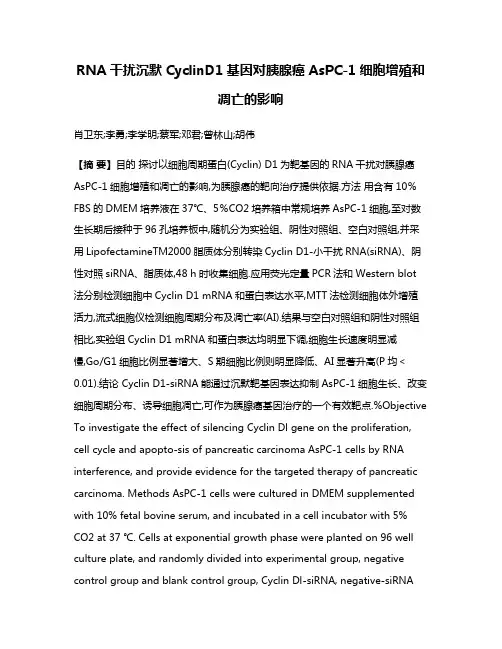
RNA干扰沉默CyclinD1基因对胰腺癌AsPC-1细胞增殖和凋亡的影响肖卫东;李勇;李学明;蔡军;邓君;曾林山;胡伟【摘要】目的探讨以细胞周期蛋白(Cyclin) D1为靶基因的RNA干扰对胰腺癌AsPC-1细胞增殖和凋亡的影响,为胰腺癌的靶向治疗提供依据.方法用含有10%FBS的DMEM培养液在37℃、5%CO2培养箱中常规培养AsPC-1细胞,至对数生长期后接种于96孔培养板中,随机分为实验组、阴性对照组、空白对照组,并采用LipofectamineTM2000脂质体分别转染Cyclin D1-小干扰RNA(siRNA)、阴性对照siRNA、脂质体,48 h时收集细胞.应用荧光定量PCR法和Western blot 法分别检测细胞中Cyclin D1 mRNA和蛋白表达水平,MTT法检测细胞体外增殖活力,流式细胞仪检测细胞周期分布及凋亡率(AI).结果与空白对照组和阴性对照组相比,实验组Cyclin D1 mRNA和蛋白表达均明显下调,细胞生长速度明显减慢,Go/G1细胞比例显著增大、S期细胞比例则明显降低、AI显著升高(P均<0.01).结论 Cyclin D1-siRNA能通过沉默靶基因表达抑制AsPC-1细胞生长、改变细胞周期分布、诱导细胞凋亡,可作为胰腺癌基因治疗的一个有效靶点.%Objective To investigate the effect of silencing Cyclin Dl gene on the proliferation, cell cycle and apopto-sis of pancreatic carcinoma AsPC-1 cells by RNA interference, and provide evidence for the targeted therapy of pancreatic carcinoma. Methods AsPC-1 cells were cultured in DMEM supplemented with 10% fetal bovine serum, and incubated in a cell incubator with 5% CO2 at 37 ℃. Cells at exponential growth phase were planted on 96 well culture plate, and randomly divided into experimental group, negative control group and blank control group, Cyclin Dl-siRNA, negative-siRNAand lipofectamine were transfected into AsPC-1 cells mediated by Lipofectamine TM 2000, and the cells were collected at 48 h after transfection. The expression of Cyclin Dl Mrna and protein of the transfected cells were analyzed by real-time RT-PCR and Western blot, cell growth was measured with MTT assay, cell cycle and apoptosis rate (AI) was examined by flow cy tome try. Results The expression of Cyclin Dl Mrna and protein in experimental group were markedly down-regulated compared with control groups (P < 0.01). The cell growth of experimental group was significantly slower than that of control groups (P <0.01). The percentage of G0/G1 stage cells was significantly higher, while the percentage of S stage cells was significantly lower in experimental group compared with those in control groups (P <0.01). The apoptosis rate of experimental group was significantly higher than that of control groups (P <0.01). Conclusion Down-regulation of Cyclin Dl can inhibit the growth of pancreatic carcinoma AsPC-1 cells, change cell cycle distribution and induce cell apoptosis. Cyclin Dl gene may serve as an effective target for the gene therapy of pancreatic carcinoma.【期刊名称】《山东医药》【年(卷),期】2011(051)043【总页数】3页(P20-22)【关键词】胰腺肿瘤,胰腺癌;Cyclin D1基因;RNA干扰;细胞增殖;细胞凋亡【作者】肖卫东;李勇;李学明;蔡军;邓君;曾林山;胡伟【作者单位】南昌大学第一附属医院,南昌 330006;南昌大学第一附属医院,南昌330006;南昌大学第一附属医院,南昌 330006;南昌大学第一附属医院,南昌330006;南昌大学第一附属医院,南昌 330006;南昌大学第一附属医院,南昌330006;南昌大学第一附属医院,南昌 330006【正文语种】中文【中图分类】R735.9近年研究显示,细胞周期失控与肿瘤发生、发展密切相关,而调控细胞周期诸多因素的核心是细胞周期蛋白(Cyclin)与细胞周期蛋白依赖性激酶(CDK)。
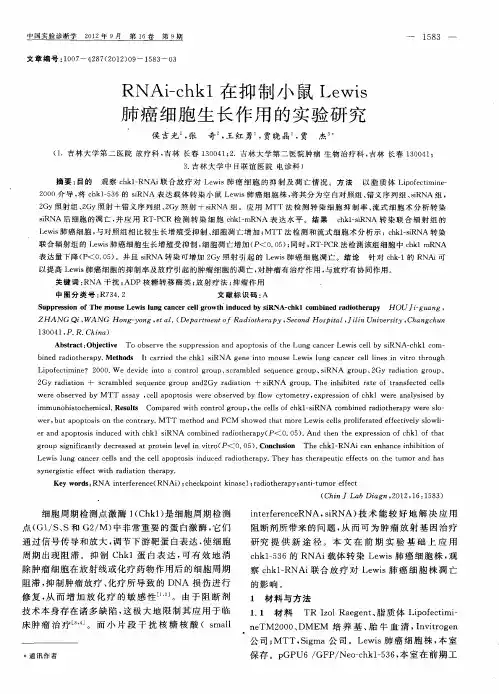
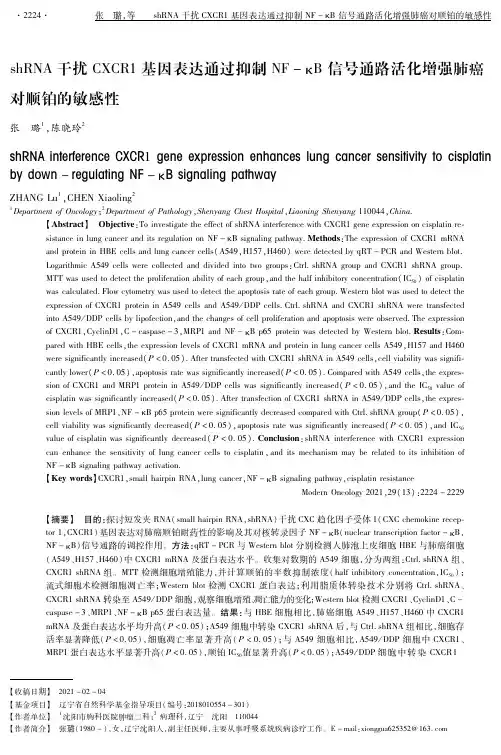
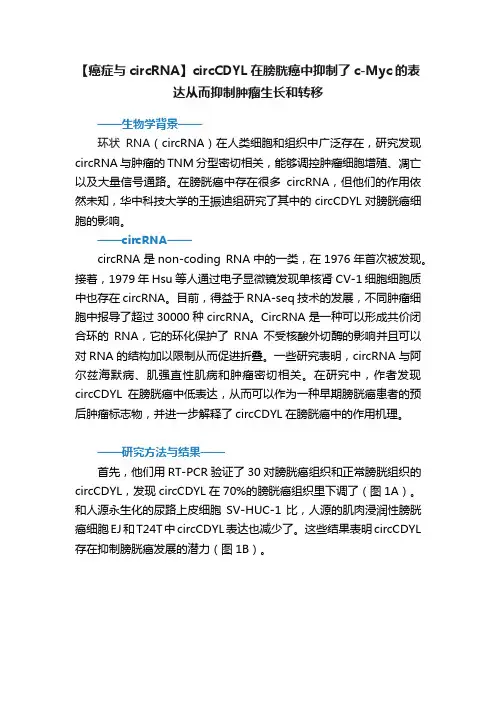
【癌症与circRNA】circCDYL在膀胱癌中抑制了c-Myc的表达从而抑制肿瘤生长和转移——生物学背景——环状RNA(circRNA)在人类细胞和组织中广泛存在,研究发现circRNA与肿瘤的TNM分型密切相关,能够调控肿瘤细胞增殖、凋亡以及大量信号通路。
在膀胱癌中存在很多circRNA,但他们的作用依然未知,华中科技大学的王振迪组研究了其中的circCDYL对膀胱癌细胞的影响。
——circRNA——circRNA是non-coding RNA中的一类,在1976年首次被发现。
接着,1979年Hsu等人通过电子显微镜发现单核肾CV-1细胞细胞质中也存在circRNA。
目前,得益于RNA-seq技术的发展,不同肿瘤细胞中报导了超过30000种circRNA。
CircRNA是一种可以形成共价闭合环的RNA,它的环化保护了RNA不受核酸外切酶的影响并且可以对RNA的结构加以限制从而促进折叠。
一些研究表明,circRNA与阿尔兹海默病、肌强直性肌病和肿瘤密切相关。
在研究中,作者发现circCDYL在膀胱癌中低表达,从而可以作为一种早期膀胱癌患者的预后肿瘤标志物,并进一步解释了circCDYL在膀胱癌中的作用机理。
——研究方法与结果——首先,他们用RT-PCR验证了30对膀胱癌组织和正常膀胱组织的circCDYL,发现circCDYL在70%的膀胱癌组织里下调了(图1A)。
和人源永生化的尿路上皮细胞SV-HUC-1比,人源的肌肉浸润性膀胱癌细胞EJ和T24T中circCDYL表达也减少了。
这些结果表明circCDYL 存在抑制膀胱癌发展的潜力(图1B)。
图1 circCDYL在膀胱癌组织和细胞系中的表达接着作者将circCDYL稳转入EJ和T24T细胞,CCK8试剂表明过表达circCDYL大大的降低了EJ和T24T细胞的生长速率,尤其是在72h后(图2)。
同时,流式细胞实验证明过表达circCDYL使细胞阻滞在G0-G1期(图3)。

趋化因子CXCL1在巨噬细胞-肝癌微环境中表达状况及对肝癌进展的影响背景:趋化因子CXCL1在多种癌症中发挥着重要的作用,然而其在巨噬细胞-肝癌微环境中的表达及其对肝癌进展的影响尚不清晰。
目标:本文的目标是探究CXCL1在巨噬细胞-肝癌微环境中的表达状况,并探讨其对肝癌进展的影响。
方法:我们接受免疫组织化学和实时荧光定量PCR技术检测了CXCL1在肝癌组织和对应癌旁组织中的表达,并对肝癌病人的临床病理学参数进行了统计分析。
结果:CXCL1在肝癌组织中表达显著增加,并与肝癌的大小、浸润度以及肿瘤分期呈正相关。
此外,我们也观察到CXCL1高表达的肝癌患者预后较差。
结论:CXCL1在巨噬细胞-肝癌微环境中表达提高,并且与肝癌的进展和预后密切相关。
因此,CXCL1可能成为肝癌治疗的一个新的靶点。
关键词:肝癌;CXCL1;巨噬细胞;微环境;预后Abstract:Background: Chemokine CXCL1 plays an important role in various cancers. However, its expression in macrophage-liver cancer microenvironment and itsimpact on liver cancer progression are still unclear.Purpose: The purpose of this study was to investigate the expression of CXCL1 in the macrophage-liver cancer microenvironment and explore its impact on livercancer progression.Methods: We used immunohistochemistry and real-time quantitative PCR to detect the expression of CXCL1 in liver cancer tissues and corresponding adjacent tissues, and analyzed the clinical pathological parameters of liver cancer patients.Results: CXCL1 was significantly upregulated in liver cancer tissues and positively correlated with the size, invasion degree and tumor stage of liver cancer. In addition, we also observed that liver cancer patients with high CXCL1 expression had a poor prognosis.Conclusion: CXCL1 was upregulated in the macrophage-liver cancer microenvironment and closely related to the progression and prognosis of liver cancer.Therefore, CXCL1 may become a new target for liver cancer treatment.Keywords: liver cancer; CXCL1; macrophages; microenvironment; prognosi。
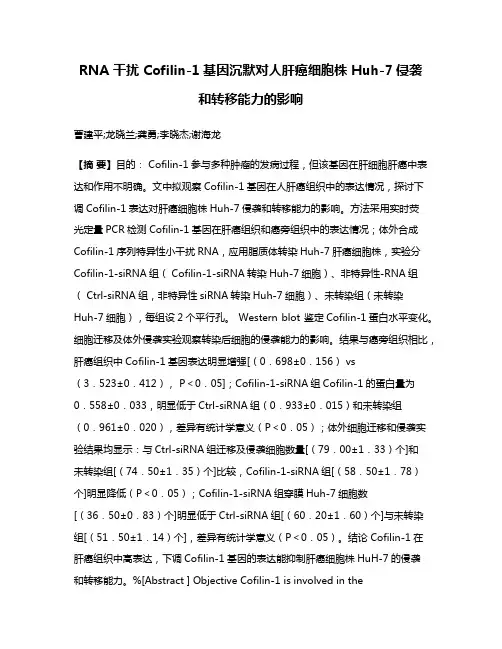
RNA 干扰 Cofilin-1基因沉默对人肝癌细胞株 Huh-7侵袭和转移能力的影响曹建平;龙晓兰;龚勇;李晓杰;谢海龙【摘要】目的: Cofilin-1参与多种肿瘤的发病过程,但该基因在肝细胞肝癌中表达和作用不明确。
文中拟观察Cofilin-1基因在人肝癌组织中的表达情况,探讨下调Cofilin-1表达对肝癌细胞株Huh-7侵袭和转移能力的影响。
方法采用实时荧光定量PCR检测Cofilin-1基因在肝癌组织和癌旁组织中的表达情况;体外合成Cofilin-1序列特异性小干扰RNA,应用脂质体转染Huh-7肝癌细胞株,实验分Cofilin-1-siRNA组( Cofilin-1-siRNA转染Huh-7细胞)、非特异性-RNA组( Ctrl-siRNA组,非特异性siRNA转染Huh-7细胞)、未转染组(未转染Huh-7细胞),每组设2个平行孔。
Western blot 鉴定Cofilin-1蛋白水平变化。
细胞迁移及体外侵袭实验观察转染后细胞的侵袭能力的影响。
结果与癌旁组织相比,肝癌组织中Cofilin-1基因表达明显增强[(0.698±0.156) vs(3.523±0.412), P<0.05];Cofilin-1-siRNA组Cofilin-1的蛋白量为0.558±0.033,明显低于Ctrl-siRNA组(0.933±0.015)和未转染组(0.961±0.020),差异有统计学意义(P<0.05);体外细胞迁移和侵袭实验结果均显示:与Ctrl-siRNA组迁移及侵袭细胞数量[(79.00±1.33)个]和未转染组[(74.50±1.35)个]比较,Cofilin-1-siRNA组[(58.50±1.78)个]明显降低(P<0.05);Cofilin-1-siRNA组穿膜Huh-7细胞数[(36.50±0.83)个]明显低于Ctrl-siRNA组[(60.20±1.60)个]与未转染组[(51.50±1.14)个],差异有统计学意义(P<0.05)。

肝癌的转录组和表观遗传学研究肝癌是一种高度复杂且致命的肿瘤类型,其发病机制至今尚不完全清楚。
然而,随着转录组学和表观遗传学的快速发展,我们对于肝癌发生和发展的研究取得了突破性进展。
本文将对肝癌的转录组和表观遗传学研究进行探讨,以期增加对这一疾病的认识。
一、转录组学研究转录组学是研究细胞内所有转录本的产物,即mRNA的全集。
通过转录组学研究,我们可以全面了解肝癌中基因表达的变化情况,从而揭示其发生机制。
研究表明,与正常细胞相比,肝癌细胞中存在大量基因的异常表达。
这些异常表达的基因涉及到细胞生长、凋亡、血管生成等重要生物学过程,从而导致了肝癌的发展。
1. 转录组变异与肝癌研究发现,肝癌细胞中存在大量的基因变异。
这些变异可能是由致癌基因的点突变、染色体结构异常或基因拷贝数的改变所导致。
通过对这些变异基因的分析,我们可以发现一些与肝癌进展相关的重要驱动基因。
例如,肝癌中常见的TP53基因突变在细胞凋亡的调控中起着关键作用。
2. 转录组学的亚型分类基于转录组学的研究,肝癌可以被进一步分为不同的亚型。
这些亚型在基因表达模式、临床症状和预后上存在差异。
通过对肝癌亚型的研究,我们可以更好地了解肝癌的异质性,并为个体化治疗提供依据。
3. 转录组学在预后评估中的应用转录组学研究不仅可以帮助我们理解肝癌的发生机制,还可以用于预测肝癌患者的预后。
通过分析肝癌组织中的基因表达谱,我们可以得到与预后相关的基因指标,为临床预后评估提供参考。
二、表观遗传学研究表观遗传学是研究影响基因表达的可逆性调控机制。
在肝癌中,表观遗传学调控的异常常常导致基因的错配表达,从而促进肿瘤的发展。
1. DNA甲基化DNA甲基化是表观遗传学中最为重要的调控方式之一。
研究发现,在肝癌中存在大量基因的异常DNA甲基化。
这些异常的DNA甲基化可能导致基因的沉默或过度表达,从而促进肝癌的发生。
2. 组蛋白修饰组蛋白修饰是另一种常见的表观遗传学调控方式。
研究表明,在肝癌中存在组蛋白修饰的异常,如乙酰化、甲基化和泛素化等。

核酸靶向治疗癌症的研究进展近年来,核酸靶向治疗作为一种新型的治疗方法,备受研究者的关注。
不同于传统的放化疗,核酸靶向治疗具有高效、准确、无副作用等优点,已经被广泛应用于多种癌症的治疗中。
什么是核酸靶向治疗?核酸靶向治疗,顾名思义,即是通过有针对性的靶向核酸分子,比如siRNA(小干扰RNA)、miRNA(微小干扰RNA)、antisense DNA(反义DNA)等,来抑制致癌基因的表达,增强致癌基因的拮抗效应,最终达到治疗癌症的目的。
核酸分子在转录本水平靶向基因,其中的各种小分子具有不同的特性,但都是单链RNA分子,通常包括siRNA、shRNA、miRNA和PiwiRNA等。
siRNA是短小的(21-23bp),双链的RNA分子,ShRNA是同样的形式,但是对RNA干扰酶的依赖性更强。
MiRNA和PiwiRNA通常是单链的,更长,比如70bp或更长,在细胞的RNA结合蛋白(RBP)的辅助下,与特定的RISC和piRNA复合物结合,与基因的单链mRNA匹配,这样就使mRNA被降解,进而调控靶向基因的表达。
而antisense DNA则是通过互补配对靶向的方式来抑制基因的表达。
核酸靶向治疗的研究现状核酸靶向治疗是一种以基因为靶点的靶向治疗手段,它通过干预、抑制或消除治疗癌症的特定基因来抑制肿瘤细胞的生长,减轻或消除其对机体的危害。
近年来,这一治疗手段的研究已经取得了长足的进展。
1. siRNA的应用siRNA是双链RNA分子,研究表明它在肿瘤细胞中的高表述可导致细胞的凋亡。
因此, siRNA在癌症治疗中被广泛应用,不仅对单个基因进行靶向干扰,也可以对多个基因进行同时的干扰。
同时,由于siRNA具有高效性和特异性,使其成为肿瘤细胞生物学研究最常用的小分子检测工具之一。
2. miRNA的应用miRNA与siRNA类似,同样也可以用于癌症治疗。
miRNA通过与mRNA互补配对,调节特定靶向基因的表达,进而影响肿瘤细胞的增殖和凋亡。
shRNA双表达载体pCSH1的构建及抗肿瘤活性研究何红伟;李保卫;任开环;邵荣光【摘要】目的构建一种可同时表达靶向两种基因shRNA的瞬时表达载体,以提高RNA干扰效率和降低载体的非特异毒性.方法载体采用pUC19的质粒基本序列,RNA聚合酶Ⅲ识别的H1启动子,并利用同尾酶的特性设计两个多克隆位点,用DNA重组技术构建了载体pCSH1;以pCSH1为基础,构建靶向N-Ras或c-Myc 的单干扰载体,以及靶向N-Ras和c-Myc的双干扰载体,并验证其干扰效率;并用克隆形成法验证了载体的抗肿瘤活性;此外还将靶向N-Ras两个shRNA转录单位串联到一个载体中,检测该连接方式的优势.结果成功设计并构建了可同时表达双基因shRNA的瞬时表达载体pCSH1.对该载体的验证结果表明,靶向N-Ras的单干扰shRNA表达载体pCSH1-shNR或靶向c-Myc的单干扰shRNA表达载体pCSH1-shMyc对靶基因mRNA和蛋白具有明显的干扰作用;双干扰载体pCSH1-shNM也能同时抑制N-Ras和c-Myc的mRNA和蛋白表达水平,且对细胞克隆形成的抑制率最高.细胞生长曲线法检测两个N-Ras-shRNA表达单位串联的载体pCSH1-2shNR对细胞生长的抑制作用,结果显示在质粒质量相同条件下,双表达载体pCSH1-2shNR对细胞的生长抑制作用显著强于单N-Ras-shRNA表达载体pCSH1-shNR,而相同质量的对照质粒pCSH1-2shMock、pCSH1-shMock对细胞生长的抑制没有明显差异.结论利用同尾酶原理构建了一个可同时表达双shRNA的瞬时表达载体pCSH1,该载体可实现双基因同时干扰;pCSH1还具有分子量小、shRNA表达单位可以串联和串联后RNA干扰活性增强的优点.该载体通过同时抑制两个靶基因或增加对单个靶基因的shRNA表达单位可以取得更好的抗肿瘤活性.【期刊名称】《中国医药生物技术》【年(卷),期】2010(005)004【总页数】6页(P246-251)【关键词】RNA干扰;遗传载体;基因表达调控,肿瘤【作者】何红伟;李保卫;任开环;邵荣光【作者单位】100050,北京,中国医学科学院北京协和医学院医药生物技术研究所;100050,北京,中国医学科学院北京协和医学院医药生物技术研究所;100050,北京,中国医学科学院北京协和医学院医药生物技术研究所;100050,北京,中国医学科学院北京协和医学院医药生物技术研究所【正文语种】中文RNA 干扰(RNAi)技术是一种非常有潜力的疾病治疗手段,具有干扰特异性高、可同时干扰多个基因的特点[1-3]。
shRNA抑制CLIC1基因表达对小鼠肝癌细胞株Hca-F生物学行为的影响大连医科大学博士学位论文shRNA抑制CLIC1基因表达对小鼠肝癌细胞株Hca-F生物学行为的景程姓名:李荣宽申请学位级别:博士专业:病理与病理生理学指导教师:唐建武201006shRNA抑制CLIC 1基因表达对小鼠肝癌细胞株Hca.F生物学行为的影响博士研究生:李荣宽指导教师:唐建武教授专业名称:病理学与病理生理学摘要背景:转移潜能是恶性肿瘤最重要的生物学特征之一,也是肿瘤患者死亡率高、预后差的主要原因。
对于上皮来源的恶性肿瘤,淋巴道转移是其早期转移的主要方式,但确切机制目前仍不清楚。
原发性肝癌(primary carcinoma of the liver)是最常见恶性肿瘤之一,包括肝细胞癌(hepatocellular carcinoma,HCC)、肝内胆管上皮癌(intrahepaticcholangiocarcinoma,IHCC)、肝细胞及胆管上皮细胞混合癌三种细胞类型,其中90%以上为肝细胞癌。
全世界每年新发约62.6万例HCC患者,其中的半数以上病例发生在我国。
同时,它也是恶性程度最高、致死率最高的肿瘤之一,位居全球恶性肿瘤死因第三位、我国恶性肿瘤死因第二位。
即便是经过根治性切除手术治疗,5年的复发转移率仍高达60%,因此,揭示肝癌转移的分子机制及其关键调控环节,进而采取相应的干预措施,将有助于减少、甚至避免病人术后发生复发转移,从而达到降低死亡率的目的。
Hca.F和Hca.P是将小鼠肝癌细胞株H22在61 5小鼠体内反复接种和筛选后得到的一对来源于同一亲本细胞、但是淋巴道转移潜能显著不同的小鼠肝癌腹水型细胞株。
其中Hca.F具有高淋巴道转移潜能,接种到6l 5小鼠体内后其淋巴结转移率超过70%,Hca.P是低转移潜能的细胞株,其淋巴结转移率低于30%。
通过对比研究二者的差异,可以为我们揭示小鼠肝癌的淋巴道转移机制提供有益的参考。
本课题组在前期工作中已经应用不同的方法,对Hca.F和Hca.P这一对具有高低不通淋巴道转移潜能的细胞株进行了一系列系统的研究。
首先,利用抑制性消减杂交技术(suppression substractive hybridization,SSH)及基因芯片(Genechip)高通量筛选(high throughput screen,HTS)技术得出了Hca.F细胞和Hca.P细胞之间一系列差异表达基因,继而采用定量蛋白质组学技术建立了高低淋巴道转移潜能小鼠肝癌细胞的荧光差异蛋白表达图谱。
在诸多差异基因和蛋白质中,细胞内氯离子通道1(chloride intracellular channel 1,CLICl)在Hca.F细胞中的表达都显著高于Hca.P 细胞,其中在mRNA水平(基因芯片)上,CLIC l在Hca.F细胞中的表达是其在Hca.P细胞中表达量的3.48倍,在蛋白水平(双向免疫荧光差异电泳)上,Hca.F中的CLICl表达量是Hca.P的1.6倍,提示CLICI可能与小鼠肝癌的淋巴道转移潜能相关。
由于人类组织细胞中具有CLIC 1同源蛋白,因此,研究小鼠肝癌细胞株CLICl与淋巴道转移的关系,对人类肝癌淋巴道转移的防治必然具有重要意义。
CLICl是氯离子通道家族中的一员,又称NCC27,是一种氯离子通道蛋白。
通常其在细胞中以两种形式存在:溶解于胞浆中的可溶型和结合于胞膜上的膜结合型。
研究表明CLICl的作用不仅局限于细胞内外离子的运输,而且和许多疾病,尤其是肿瘤性疾病有密切的关系。
有学者发现CLIC l在乳腺癌、肺癌、肝细胞癌、胆囊癌、胃癌以及大肠癌等多种肿瘤细胞中表达明显增强,同时发现其与胃癌和胆囊癌的淋巴结侵袭能力显著相关,提示CLIC l可能是参与肿瘤发生及淋巴道转移的重要基因之一。
本研究以CLICl为研究对象,探索其在Hca.F细胞株淋巴道转移过程中的作用。
经检索,目前国内外尚无CLIC l与肝癌淋巴道转移关系的研究报道。
目的:1.在蛋白质水平上比较CLICl在淋巴道转移潜能不同的小鼠肝癌细胞系Hca.F和Fca.P中的表达,为进一步研究肝癌淋巴道转移的机制奠定基础。
2.构建pGPU6/GFP/Neo—shRNA表达载体,稳定转染Hca.F细胞,得到CLICl的表达被明显下调的Hca.F细胞株。
3.对比研究小鼠肝癌细胞株Hca—F在CLICl表达水平下调前后其细胞增殖能力、细胞周期与凋亡情况、细胞迁移和侵袭能力等方面的变化,探讨CLICl基因的表达对小鼠肝癌细胞生物学行为的影响。
方法:1.采用蛋白免疫印迹(Western Blotting)方法检测Hca-F和Hca.P细胞株中CLICl的表达差异。
2.依据Gene Bank中小鼠CLICl基因序列设计合成3条shRNA的DNA模板的两条单链,分别命名为shRNA.1、shRNA.2、shRNA.3,同时设计shRNA.无关序列作为阴性对照(negative control,NC)。
进而与pGPU6/GFP/Neo质粒构建表达载体,分别命名为pGPU6/GFP/Neo.shRNA-l、pGPU6/GFP/Neo—shRNA-2、pGPU6/GFP/Neo.shRNA.3、pGPU6/GFP/Neo.shRNA—NC。
对三条pGPU6/GFP/Neo.shRNA表达载体经测序鉴定,结果与我们设计的三条shRNA序列以及Gene Bank中的序列相比对,确定序列无误,将三组2pGPU6/GFP/Neo.shRNA表达载体和阴性对照pGPU6/GFP/Neo.shRNA.NC分别应用阳离子聚合物转染试剂梭华一SofastTM稳定转染至Hca.F细胞中,经G4 l 8筛选,获得稳定转染表达载体pGPU6/GFP/Neo.shRNA的Hca.F细胞。
以空白对照组(未转染的Hca.F细胞株)为参照,应用Real.time RT-PCR和Western Blotting方法在mRNA水平和蛋白质水平上检测三组pGPU6/GFP/Neo.shRNA对CLIC 1基因表达的抑制作用,以筛选出RNA干扰效果最好的一组表达载体用于后续实验。
3.以三组细胞(分别为Hca.F细胞株、稳定转染pGPU6/GFP/Neo.shRNA.NC的Hca.F细胞株、经筛选稳定转染干扰效率最好的pGPU6/GFP/Neo.shRNA表达载体的Hca.F细胞株)为实验对象。
应用CCK.8试剂盒检测三组细胞的增殖能力;应用流式细胞仪检测三组细胞的细胞周期和凋亡情况;应用Transwell小室检测CLICl的表达被pGPU6/GFP/Neo.shRNA下调后Hca.F细胞的迁移能力和侵袭能力的变化。
结果:1.CLICl蛋白在小鼠腹水型肝癌细胞株Hca.F和Hca.P中均有表达,CLICl在Hca.F细胞株中的表达是其在Hca.P中的1.33倍。
2.靶向CLICl mRNA的三个pGPU6/GFP/Neo.shRNA重组质粒表达载体经测序分析,以及经过限制性内切酶酶切后电泳证实载体构建成功。
三组重组质粒表达载体稳定转染Hca.F细胞后,经验证pGPU6/GFP/Neo· shRNA.2对CLIC l表达抑制的效果最好,因而被选择作为后续实验的CLICl稳定下调的细胞株。
3.CCK.8实验结果显示CLIC l基因表达下调后Hca.F细胞增殖情况明显增强;流式细胞仪检测结果显示CLIC 1基因表达下调后,停留于G2/M期的Hca.F细胞数目比例明显增多(下调组46.07%’;空白对照组1 6.72%;阴性对照组l 9.79%,’P<0.05),凋亡细胞比例显著减少(下调组5.33%’:空白对照组29.78%;阴性对照组28.53%,’尸<0.05):体外迁移实验结果显示CLIC l表达下调后穿膜细胞数明显低于空白对照组和阴性对照组(下调组1 28.67 4-33.54’:空白对照组214.53士24.96;阴性对照组1 97.73 4-24.48,’P<0.05);体外侵袭实验结果显示CLIC l表达下调后穿过人工基底膜的细胞数明显低于空白对照组和阴性对照组(下调组50.73 4-3.89’;空白对照组98.93 4-5.00;阴性对照组96.27 4-2.60,’P<0.05)。
结论:1.CLICl在小鼠腹水型肝癌细胞系Hca—F和Hca-P均有表达,在Hca.F细胞株中的表达量明显高于在Hca.P中的表达。
2.利用真核细胞表达质粒pGPU6/GFP/Neo和shRNA成功构建了三组pGPU6/GFP/Neo.shRNA表达载体,并稳定转染Hca.F细胞株,获得CLICl表达稳定下调的Hca—F细胞株,经过检验,pGPU6,GFP,Neo.shRNA.2对Hca.F 细胞中CLICl抑制效果最明显,通过其下调CLICl在Hca.F细胞中的表达,提供了揭示CLICl基因在小鼠肝癌淋巴道转移潜能中所起作用的可能。
3.CLICl作为小鼠肝癌细胞株Hca.F和Hca.P的差异表达蛋白质,降低其表达水平可促进小鼠肝癌细胞的增殖,使得停留于细胞周期中G2/M 期的细胞数量增多,凋亡细胞数量减少,并且能够降低小鼠肝癌细胞的体外迁移和侵袭能力,提示CLIC l基因具有抑制小鼠肝癌细胞增殖、调节细胞周期、促进肿瘤细胞凋亡、促进肿瘤细胞的迁移和侵袭能力的作用,表明其在Hca.F细胞的淋巴道转移潜能机制中可能起着重要的作用。
关键词:氯离子通道蛋白l 肝癌RNA干扰淋巴道转移4Study about the influence on mouse hepatocellular carcinoma cell by inhibiting the expression of CLIC 1gene with shRNADoctor Degree Candidate:Li RongkuanSupervisor:Professor Tang Jianwu Major:Pathology and PathophysiologyA bstractBackground:Metastasis is one of the most important biological characteristics of malignant tumor,at the same time,it is the fundamental cause of high mortality and poor prognosis of the patients who suffer from malignant tumors.Lymphatic metastasis is the early mode in epithelial malignant tumors,but the mechanism of it iS unclear.As one of the most common malignant tumor,the primary carcinoma of the liver includes 3types:hepatocellular carcinoma(HCC),which accounts more than 90%.and the other types are intrahepatic cho】angiocarcinoma(mcc)and the mixedtypehalf in carcinoma.There are about 626,000 newcases of HCC and more than China.Meanwhile,as one of the most fatal malignant tumor,HCC has a high relapse incidence though the mass has been cut off closely.Therefore,to reveal the mechanism and the key steps in metastasis of HCC is helpful for reducing the mortality of it.Hca—P and Hca—F is a pair of syngenetic mouse hepatocarcinoma ascites cell lines which have different rates of lymphatic metastasis.Hca.F is the cell line whose metastatic rate is more than 70%,compared with it,Hea-P has a low lymphatic metastasis rate,which is less than 30%.They are the ideal models for the research of mechanism of lymphatic metastasis.Our research team has engaged in the study about the mechanism of lymphatic metastasis.We have picked out the lymphatic metastasis..associated genes in mouse hepatocarcinoma cell lineshybridization and high throughput screen of by using suppressive subtractivegenechips assays respectively and obtained the lymphatic metastasis—associated proteins by using quantitative proteomics technique.The expressing level of CLIC 1 was muchhigher in Hca-F than that in Hca-P cell lines in both tuRNA and protein levels which showed that CLIC 1 maybe play an important role in lymphatic metastasis of mouse hepatocarcinoma.Because there is the same origin of CLIC 1 protein in the tissue of both human being and mouse,it is very helpful to study thefunction of CLIC 1 in the lymphatic metastasis of mousehepatocarcinoma.CLIC 1,also known as NCC27,is a member of the family of chloride intracellular ion channels.As a chloride channel,which play an important role ifl the cells.CLIC 1 usually exists in both soluble and memberane-assosiated forms.Studies have shown that the role of CLIC 1 iS not limited to intra and extra cellular ion transport,but also,and many diseases,especially neoplastic diseases are closely related to.Some scholars have found that CLIC 1 markedlyenhanced expression in breast cancer,lung cancer,gallbladder cancer,hepatoeellular carcinoma,colorectal cancer,gastricwell as a variety of tumor cells,and found it was significantly cancer,ascorrelated with lymph node invasion in stomach and gallbladder carcinoma,suggesting that CLIC I may be one of the importantgenes involved in tumor occurrence and lymphatic metastasis.In this study,CLIC 1 as the research object to explore in Hca-F cell line.There was not the same reports home and abroad by retrieval.O bj ective:1.T0 observe the different expression level s of CLIC 1 in mouse hepatocarcinoma ascites eell lines Hca—F and Hca-P by Westen Blottin for further study of its function and mechanism in lymphatic metastasis of hepatoearcinoma.2.To build expression vector of pGPU6/GFP/Neo.shRNA and get cell line Hca—F which expression of CLIC 1 has been markedly decreased after stable transfection.3.To study the influence on proliferation,cell cycle,apoptosis,migration and invasion of mouse hepatocellular carcinoma cell line Hca-F after down regulation of CLIC 1expression by shRNA and discuss the correlation between expressing level of CLIC 1 and lymphatic metastasis of mouse hepatocareinoma.Methods:1.The expression of CLIC 1 protein was detected in mouseWestern hepatocarcinoma ascites cell lines of Hca-F and Hca—P byshRNAs(shRNA-I,shRNA-2,shRNA一3)and unrelated Blotting.2.Threesequence were designed according tO the gene sequence of CLIC 1(NM一003 3444)in6Gerie Bank.pGPU6/GFP/Neo vector was obtained and restriction enzymes were used to digest.The annealing of shRNA compositive sequence was performed and T4 DNA ligase was used to connect the pGPU6/GFP/Neo vector with three shRNAs and unrelated sequence(negative control,NC) after annealing.The connecting products were named pGPU6/GFP/Neo·shRNA-1,pGPU6/GFP/Neo-shRNA·2,pGPU6/GFP/Neo—shRNA·3 and pGPU6/GFP/Neo-shRNA-NC.The expressing vector was obtained by extraction of vectors.The sequence of expressing vectors was identified by sequencing and the result was compared to that in Gene Bank.The three pGPU6/GFP/Neo-shRNA expressing vectors were transfected into Hea·F cells respectively by SofastTM reagent and the most effective pGPU6/GFP/Nco.shRNA vector was selected according to the results of Real·time RT-PCR and Western Blotting.The unrelated shRNA transfected Hca-F cell line and normal Hca—F cell line were negative control group and blank control group respectively.3.The cell viability was evaluated by CCK一8.The cell cycle and apoptosis were evaluated by flow cytometry.The cell migration and invasion capability were evaluated by transwell assays.Results:1.The expression of CLIC 1 in cell line Hca—F was 1.33 times more than that in Hca.P.2.The expression vector of pGPU6/GFP/Neo·shRNA was built and transfected into Hca.F cells successfully.The sequence of three shRNAs was identified by sequencing and the result was identical to that in Oene Bank.At the same time,all expression vectors were verified by restriction enzyme cutting to be built successfully.The expression vector pGPU6/GFP/Neo·shRNA一2 was the most effective one.The expressions of mRNA and protein of CLIC 1 in Hca-F ceils after transfection with pGPU6/GFP/Neo-shRNA·2were markedly decreased compared with the other groups.pGPU6/GFP/Neo-shRNA-2 group was chosen as the eell line for further study.3.The results of CCK一8 showed an obvious increase of eell proliferation was detected in pGPU6/GFP/Neo- shRNA一2group cells after the expression of CLIC 1 has been decreased.The results detected by flow cytometer showed more cells were arrested in G2/M phase and the cell percentage of apoptosis significantly decreasedafter the expression of CLIC 1 was decreased compared with the blank group and negative control group cells(P<O.05).Transwell assays showed that7both migration and invasion capability were decreased after knock.down of CLICl expression in Hca-F cell line(128.67 4-33.54’VS214.53 4-24.96,197.73 4-24.48,‘P<0.05;50.73 4-3.89‘vs98.93 4-5.00,96.27士2.60,‘P<O.05).Conclusions:1。